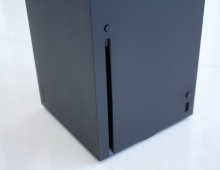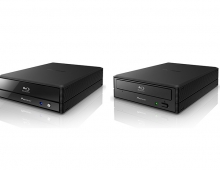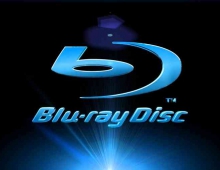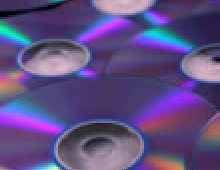
Latest Developments Related to Blu-Ray Announced at CEATEC
Prototypes of TDK's new BD-R discs capable of recording at the 6x speed, reading of 100GB BD-Rs as well as new laser diodes for 8x BD-R recording were exhibited at CEATEC 2007.
TDK's 100 Quad-layer BD-R
TDK showcased a new BD-Rs at its booth, featuring four layers and capacities of 100GB.
Instead of phase-change or a dye layer, TDK has applied a Cu/Si bilayer as a recording medium for the new discs. Under the impact of the laser pulse while disc recording, the two layers will mix, thus creating a recorded mark having a reflectivity that differs markedly from its non-irradiated environment. TDK claims that the new disc features good overall optical characteristics and that the introduced jitter is low enough (
Recording at 6x means that 25GB of data will be stored on a BD-R disc in less than 16 minutes.
Although the Blu-Ray Disc Association has not yet included the 6x recording speed for Blu-Ray, TDK said that the new 6x BD-R media is at the final stage of their engineering development.
Multi-layer BD-R reproduction by Hitachi
At the same event, Hitachi showcased a prototype optical disc device capable of reading 4-layer Blu-Ray discs (100GB). Hitachi said, that developing this technology required a drive capable of detecting which layer to read. The company has not specified how the pickup lens actually detects the readout layer, but reportedly explored a wide variety of methods including a very basic way, in which the pickup lens finds a targeted layer by scanning each layer in order of shorter distance from the optical head.
Multi-layer discs are harder to read since the information is stored on stacked recording layers, limiting the amplitude of the reflective/penetrable signal required for reading/recording. As a result, the laser light that reaches the photo detector of a reader for example, is very weak to allow for accurate retrieving of the stored data.
For future devices that read multi-layered Blu-Ray discs, the Japanese company examines the possibility to use an optical system that is able to amplify the read-back signal of a optical disc, allowing the efficient reproduction. To solve this issue, Hitachi technology allows for recovering and amplifying the weak optical signal that includes the data information in the reading process of a multi-layer optical disc. Hitachi said that the technology amplifies the reading signal by 10 times. As a result, up to 4~8 layers can be read/recorded, which means that a disc with a capacity of 100~200 GB can become a reality when using a purple/blue wavelength.
Hitachi said that it will be able to commercialize the new optical technology in 2009.
Panasonic Laser Diode For 8x BD Recording
Panasonic showcased the basic components of a future 8x Blu-Ray burner, including a 405nm, 250 mW Blue laser diode capable of offering recordings on Blu-Ray media at 8x. The company said that an 8x Blu-Ray burner is under development followed by a 12x one in the future.
TDK showcased a new BD-Rs at its booth, featuring four layers and capacities of 100GB.
Instead of phase-change or a dye layer, TDK has applied a Cu/Si bilayer as a recording medium for the new discs. Under the impact of the laser pulse while disc recording, the two layers will mix, thus creating a recorded mark having a reflectivity that differs markedly from its non-irradiated environment. TDK claims that the new disc features good overall optical characteristics and that the introduced jitter is low enough (
Recording at 6x means that 25GB of data will be stored on a BD-R disc in less than 16 minutes.
Although the Blu-Ray Disc Association has not yet included the 6x recording speed for Blu-Ray, TDK said that the new 6x BD-R media is at the final stage of their engineering development.
Multi-layer BD-R reproduction by Hitachi
At the same event, Hitachi showcased a prototype optical disc device capable of reading 4-layer Blu-Ray discs (100GB). Hitachi said, that developing this technology required a drive capable of detecting which layer to read. The company has not specified how the pickup lens actually detects the readout layer, but reportedly explored a wide variety of methods including a very basic way, in which the pickup lens finds a targeted layer by scanning each layer in order of shorter distance from the optical head.
Multi-layer discs are harder to read since the information is stored on stacked recording layers, limiting the amplitude of the reflective/penetrable signal required for reading/recording. As a result, the laser light that reaches the photo detector of a reader for example, is very weak to allow for accurate retrieving of the stored data.
For future devices that read multi-layered Blu-Ray discs, the Japanese company examines the possibility to use an optical system that is able to amplify the read-back signal of a optical disc, allowing the efficient reproduction. To solve this issue, Hitachi technology allows for recovering and amplifying the weak optical signal that includes the data information in the reading process of a multi-layer optical disc. Hitachi said that the technology amplifies the reading signal by 10 times. As a result, up to 4~8 layers can be read/recorded, which means that a disc with a capacity of 100~200 GB can become a reality when using a purple/blue wavelength.
Hitachi said that it will be able to commercialize the new optical technology in 2009.
Panasonic Laser Diode For 8x BD Recording
Panasonic showcased the basic components of a future 8x Blu-Ray burner, including a 405nm, 250 mW Blue laser diode capable of offering recordings on Blu-Ray media at 8x. The company said that an 8x Blu-Ray burner is under development followed by a 12x one in the future.





















